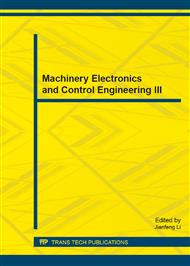[1]
Wu Huarui, Zhao Chunjiang, Zhang Haihui. Cluster head cycle-switching schemes for farmland wireless sensor networks[J]. Transactions of the CSAE, 2009, 25, (2): 170-174.
Google Scholar
[2]
Wendi Rabiner Heinzelman, Anantha Chandrakasan, and Hari Balakrishnan. Energy-Efficient Communication Protocol for Wireless Microsensor Networks[C]. Proceedings of the Hawaii International Conference on System Sciences, January 4-7, 2000, Maui, Hawaii.
DOI: 10.1109/hicss.2000.926982
Google Scholar
[3]
Hakan Bagci, Adnan Yazici. An energy aware fuzzy approach to unequal clustering in wireless sensor networks [J]. Applied Soft Computing, Volume 13, Issue 4, April 2013, Pages 1741–1749.
DOI: 10.1016/j.asoc.2012.12.029
Google Scholar
[4]
Qing Li, Zhu Qingxin, etc. Design of a distributed energy-efficient clustering algorithm for heterogeneous wireless sensor networks, Computer Communications[J]. 2006, 29(12): 2230-2237.
DOI: 10.1016/j.comcom.2006.02.017
Google Scholar
[5]
Ye W, Heidemann J, Estrin D. Medium access control with coordinated adaptive sleeping for wireless sensor networks [J]. IEEE/ACM Transactions on Networking June 2004, 12(3): 493-506.
DOI: 10.1109/tnet.2004.828953
Google Scholar
[6]
Heinzelman W, Chandrakasan A, Balakrishnan H. Energy-efficient communication protocol for wireless micro-sensor networks[C]. In Proc of the 33rd Hawaii International Conference on System Sciences Maui: IEEE Computer Society, 2000, 3005-3014.
DOI: 10.1109/hicss.2000.926982
Google Scholar
[7]
Intanagonwiwat C, Govindan R, Estrin D. Directed diffusion: a scalable and robust communication paradigm for sensor networks[C]. In Proc of ACM MOBI COM. Boston, MA, August 2000, 1-12.
DOI: 10.1145/345910.345920
Google Scholar
[8]
ZHANG Rui-hua, JIA Zhi-ping. System Design Based on Energy Efficiency in Wireless Sensor Networks [J]. Journal of Chinese Computer Systems, 2010, 1(1): 7-12.
Google Scholar
[9]
ZHANG Jun, XIANG Yu, WANG Wen-yong. Research on Power State Transition Model Wireless Sensor Network Node [J]. Journal of University of Electronic Science and Technology of China, 2009, 38(4):596-599.
Google Scholar
[10]
Krishna P, Vaidya NH, Chatterjee M, Pradhan D. A cluster-based approach for routing in dynamic networks. Proc. of the ACMSIGCOMM'97, 1997, 27(2): 49−65.
Google Scholar
[11]
Krishnan R, Starobinski D. Message-Efficient self-organization of wireless sensor networks. In: Yanikomeroglu H, ed. Proc. of theIEEE WCNC 2003. Vol 3, New York: IEEE Press, 2003. 1603−1608.
DOI: 10.1109/wcnc.2003.1200626
Google Scholar
[12]
Depedri A, Zanella A, Verdone R. An energy efficient protocol for wireless sensor networks. In: Proc. of the AINS 2003. MenloPark, 2003. 16.
Google Scholar


